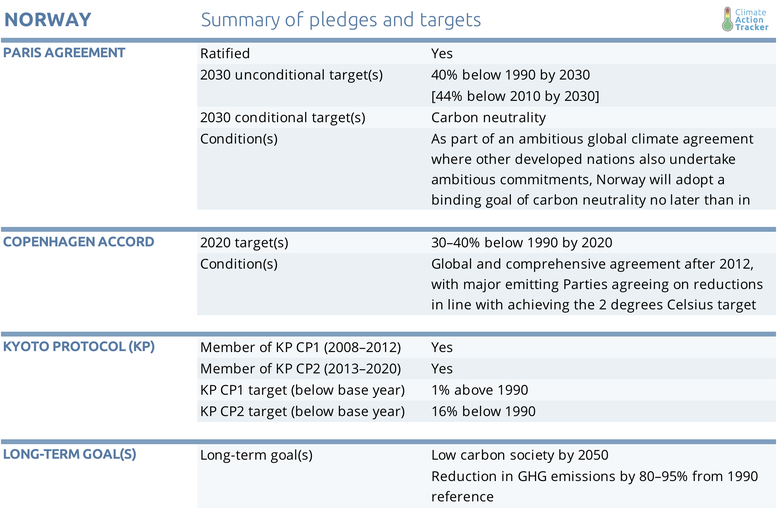Pledges And Targets
Summary table

Paris Agreement target
Norway signed and ratified the Paris Agreement in 2016. Since Norway made no new submissions, its INDC (submitted in 2015) automatically became its NDC. The NDC states the goal of reducing emissions by at least 40% below 1990 by 2030 (Norwegian Government, 2015). This stated goal is included in the third biennial report submitted by Norway, and has been legally mandated by the Norwegian parliament (Norwegian Ministry of Climate Change and Environment, 2018). On the inclusion of emissions and removals from the land use, land use change and forestry (LULUCF) sector Norway follows the EU’s regulation, requiring no net emissions from the sector between 2021-2030 (European Parliament and the Council of the European Union, 2018a; Ministry of Climate and Environment., 2019).
Norway’s current intention is to fulfil its commitment collectively with the EU. The European Commission has proposed a preliminary target for Norway for emissions reductions in sectors outside the EU Emissions Trading System of 40% by 2030 below 2005 levels (European Commission, 2016). Final targets remain subject to further calculations by the Commission (Ministry of Climate and Environment, 2016a). The target is based on Norway’s high GDP relative to other European countries (both Luxembourg and Sweden have also been given reduction targets of 40%) (European Parliament and the Council of the European Union, 2018b).
Although the base year for Norway’s NDC is set with respect to GHG emissions excluding LULUCF in 1990, Norway intends to use the land-use, land-use change and forestry sector to achieve its emissions reduction. Its NDC submission states that the 40% reduction commitment includes additional measures in the land sector, but the ‘final choice of land sector accounting shall not affect the ambition level for 2030.’
In this assessment, based on the information in the NDC, we interpret the meaning of the LULUCF approach as the following: the 40% reduction commitment is compared to 1990 GHG emissions excluding LULUCF, and this metric is to be achieved irrespective of the additional measures taken in the land sector. This approach is justified by Norway’s statement that the final choice of land sector accounting will not affect the ambition level compared with the case where this sector is not included.
Norway’s NDC also includes a conditional element with regard to its target of carbon neutrality; “as part of an ambitious global climate agreement where other developed nations also undertake ambitious commitments, Norway will adopt a binding goal of carbon neutrality no later than in 2030.” The NDC specifies “that Norway will commit to achieving emission reductions abroad equivalent to Norwegian emissions in 2030.”
In June 2016 the Norwegian parliament approved the goal of achieving “climate neutrality” by 2030 by providing climate reductions equivalent to Norwegian emissions starting in 2030 through “the EU emissions trading market, international cooperation on emissions reductions, emissions trading and project-based cooperation” (Phys, 2016; Storting, 2016). While the wording allows to assume that “climate neutrality” means emissions neutrality, it is not clear how domestic emissions in 2030 will be calculated, especially if they include LULUCF assessed around 21.2 MtCO2e. Due to its vague character and the fact that it was not yet adopted by the government, this goal is not reflected in our assessment.
2020 pledge and Kyoto target
Kyoto Protocol second commitment period (2013–2020)
Norway's target under the Kyoto Protocol’s second commitment period (2013–2020) is to reduce average GHG emissions (excluding LULUCF) by 16% (QELRO of 84) below 1990 levels, equivalent to about a 41% reduction in the year 2020, taking into account the emissions from 2013 and 2014, and assuming a linear pathway reduction from current levels. Under the Kyoto Protocol’s Land Use Change and Forestry accounting provisions, CAT estimates that Norway is likely to get an annual credit equivalent to about 1.7–3.4% of 1990 GHG emissions excluding LULUCF over the period 2013–2020. This would result in a 26–39% reduction of GHG emissions excluding LULUCF in the year 2020. The actual level of domestic emissions reductions would also depend upon emissions trading and the level of Joint Implementation (JI) and CDM (CER) units acquired or held.
With currently implemented policies and measures, Norway’s emissions are expected to increase by around 10% above 1990 levels in 2020 in GHG emissions excluding LULUCF, reaching emissions of roughly 52 MtCO2e by 2020. According to these projections, Norway will not be able to meet its Kyoto target (see figure) without acquiring emission units internationally or introducing new policies. National policy is to reduce two thirds of its GHG emissions domestically and to purchase emissions units for the rest, to the tune of up to 30 million credits during the Kyoto Protocol second commitment period.
Copenhagen Pledge
Prior to adoption of the Kyoto Protocol second commitment period target, in 2010 Norway pledged to reduce emissions by 30–40% below 1990 levels by 2020 with the 40% reduction target conditional on global action.
Long-term goal
In June 2017 the Norwegian Government adopted the goal of Norway becoming a “low carbon society” by 2050. This goal, ingrained in Climate Change Act, has been quantified as a 80–95 % reduction in GHG emissions from 1990 levels. The specific targets are to be submitted by the Norway’s government to the Storting every five years starting in 2020 and will be consistent with Norway’s NDC (Ministry of Climate and Environment, 2017a).
Further analysis
Latest publications
Stay informed
Subscribe to our newsletter




